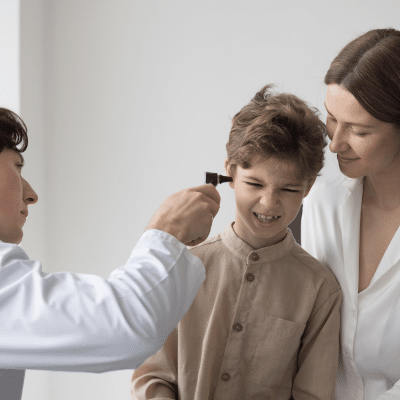 Ear infections are a common and often uncomfortable experience for toddlers and young children. These infections can disrupt sleep, cause irritability and lead to hearing difficulties, making prompt treatment essential. At Virginia ENT, our specialists are highly experienced in diagnosing and treating ear infections in children. This blog will guide our patients in Henrico, Prince George, Mechanicsville, North Chesterfield and Richmond, VA through understanding the two main types of infections—middle ear infections (otitis media) and outer ear infections (swimmer’s ear)—and how to prevent and manage them effectively.
Ear infections are a common and often uncomfortable experience for toddlers and young children. These infections can disrupt sleep, cause irritability and lead to hearing difficulties, making prompt treatment essential. At Virginia ENT, our specialists are highly experienced in diagnosing and treating ear infections in children. This blog will guide our patients in Henrico, Prince George, Mechanicsville, North Chesterfield and Richmond, VA through understanding the two main types of infections—middle ear infections (otitis media) and outer ear infections (swimmer’s ear)—and how to prevent and manage them effectively.
Understanding Middle Ear Infections (Otitis Media)
What Is a Middle Ear Infection?
Middle ear infections, or otitis media, occur when fluid or mucus builds up behind the eardrum, often due to improper function of the Eustachian tube. This tube connects the middle ear to the back of the nose and is less developed in young children, making them more prone to infections. By age three, most children experience fewer middle ear infections as their Eustachian tubes mature.
Symptoms of Middle Ear Infections
Signs of otitis media often appear suddenly and may include:
- Fever
- Irritability or behavioral changes
- Difficulty hearing
- Tugging or pulling at the ear
- Trouble sleeping
- Fussiness, especially in infants
If your child exhibits any of these symptoms, it’s important to seek medical attention. While some infections resolve on their own, most benefit from professional treatment to ensure quick relief and prevent complications.
Treatment for Middle Ear Infections
Treatment options for middle ear infections include:
- Antibiotics: These are commonly prescribed to address bacterial infections. Symptoms usually improve within a few days, while fluid drainage may take a few weeks.
- Pain Management: Over-the-counter pain relievers can help alleviate discomfort while the infection clears.
- Ear Tubes: For children experiencing frequent or severe infections, ear tubes may be recommended.
What to Expect with Ear Tubes
During a tube insertion procedure, a small silicone-coated plastic tube is placed into the eardrum to drain fluid and prevent further infections. This safe and quick procedure takes about 5-10 minutes under general anesthesia. The tubes typically last 6-12 months and fall out on their own as the ear heals.
Understanding Outer Ear Infections (Swimmer’s Ear)
What Is an Outer Ear Infection?
Outer ear infections, commonly known as swimmer’s ear, occur when water becomes trapped in the ear canal after swimming, bathing, or showering. The trapped moisture creates a favorable environment for bacteria, leading to irritation and infection.
Symptoms of Outer Ear Infections
Swimmer’s ear can affect children and adults alike, with symptoms including:
- Itchiness or irritation in the ear canal
- Muffled hearing
- Drainage from the ear
- Discomfort or mild pain
- Occasionally, a low-grade fever
Treatment for Outer Ear Infections
If swimmer’s ear is suspected, an ENT specialist can evaluate and provide appropriate treatment, such as:
- Ear Drops: Acidic or antibiotic ear drops help dry trapped moisture and eliminate infection.
- Cleaning the Ear Canal: For more severe cases, the ear canal may need to be cleaned to remove debris or bacteria.
- Medication-Soaked Sponges: In some cases, a sponge soaked in medication may be placed in the ear canal for 24-48 hours.
Preventing Ear Infections in Children
While it may not be possible to completely prevent ear infections, there are effective steps you can take to reduce your child’s risk.
For Middle Ear Infections:
- Practice Good Hygiene: Teach children to wash their hands frequently to minimize the spread of germs that can lead to upper respiratory infections.
- Avoid Secondhand Smoke: Smoke irritates the Eustachian tube, increasing the risk of infections.
- Stay Up to Date on Vaccines: Vaccinations, such as the flu shot and pneumococcal vaccine, can reduce the likelihood of infections.
For Outer Ear Infections:
- Keep Ears Dry: Encourage your child to thoroughly dry their ears after swimming or bathing. A towel or a gentle tilt of the head can help remove excess moisture.
- Use Earplugs: Earplugs or swim caps can help prevent water from entering the ears during swimming.
- Avoid Ear Canal Irritation: Teach children not to insert objects, including cotton swabs, into their ears.
When to Seek Professional Help
Prompt treatment is key to preventing complications from these infections. If your child shows signs of an infection, whether middle ear or outer ear, consulting an ENT specialist ensures they receive the appropriate care.
At Virginia ENT, we’re committed to providing compassionate and effective care for your child. Our specialists are skilled in diagnosing and treating these infections, offering relief and guidance to keep your child healthy and happy.
Request Your Appointment in Henrico, Prince George, Mechanicsville, North Chesterfield or Richmond, VA Today
Don’t let ear infections disrupt your child’s life. With the right care and preventive measures, you can ensure their ears remain healthy and infection-free.
Call (804) 484-3700 today to request your appointment or learn more about our services. At Virginia ENT, your child’s ear health is our priority!






